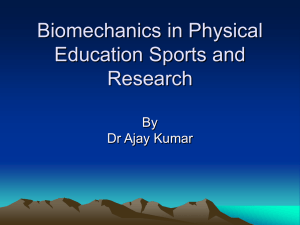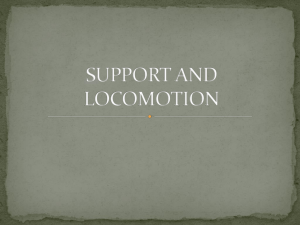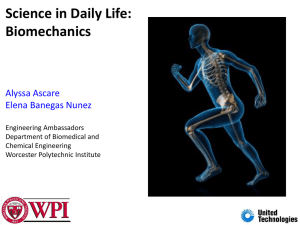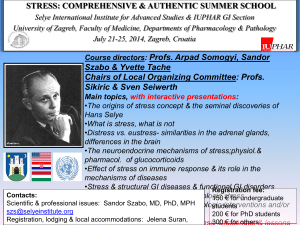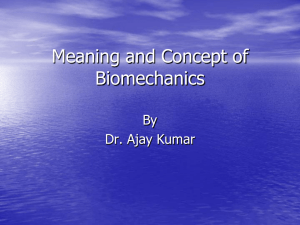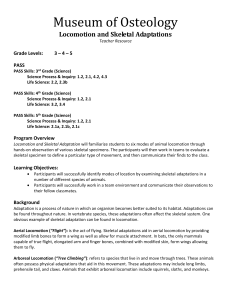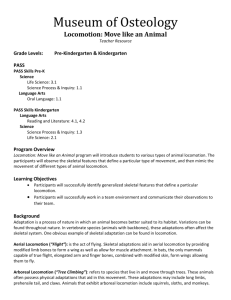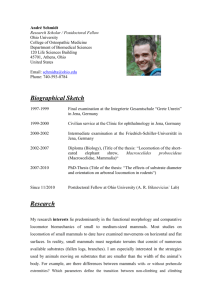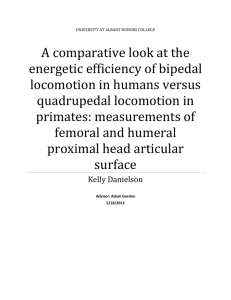167341.Experiment_vs._Modelling
advertisement
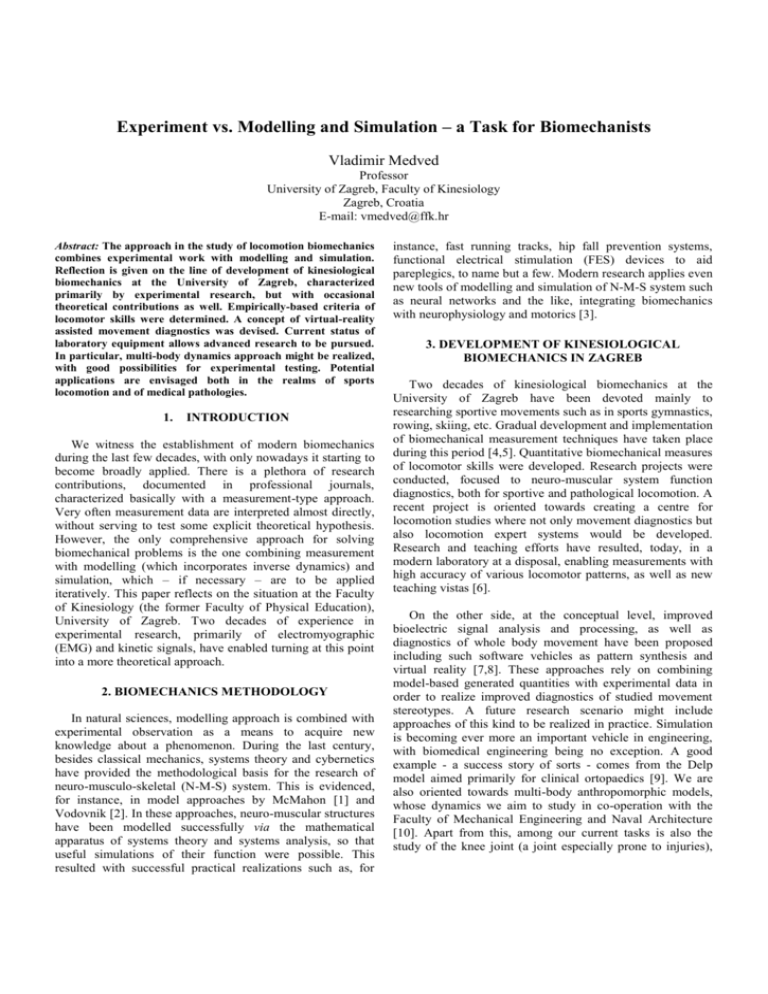
Experiment vs. Modelling and Simulation – a Task for Biomechanists Vladimir Medved Professor University of Zagreb, Faculty of Kinesiology Zagreb, Croatia E-mail: vmedved@ffk.hr Abstract: The approach in the study of locomotion biomechanics combines experimental work with modelling and simulation. Reflection is given on the line of development of kinesiological biomechanics at the University of Zagreb, characterized primarily by experimental research, but with occasional theoretical contributions as well. Empirically-based criteria of locomotor skills were determined. A concept of virtual-reality assisted movement diagnostics was devised. Current status of laboratory equipment allows advanced research to be pursued. In particular, multi-body dynamics approach might be realized, with good possibilities for experimental testing. Potential applications are envisaged both in the realms of sports locomotion and of medical pathologies. 1. INTRODUCTION We witness the establishment of modern biomechanics during the last few decades, with only nowadays it starting to become broadly applied. There is a plethora of research contributions, documented in professional journals, characterized basically with a measurement-type approach. Very often measurement data are interpreted almost directly, without serving to test some explicit theoretical hypothesis. However, the only comprehensive approach for solving biomechanical problems is the one combining measurement with modelling (which incorporates inverse dynamics) and simulation, which – if necessary – are to be applied iteratively. This paper reflects on the situation at the Faculty of Kinesiology (the former Faculty of Physical Education), University of Zagreb. Two decades of experience in experimental research, primarily of electromyographic (EMG) and kinetic signals, have enabled turning at this point into a more theoretical approach. 2. BIOMECHANICS METHODOLOGY In natural sciences, modelling approach is combined with experimental observation as a means to acquire new knowledge about a phenomenon. During the last century, besides classical mechanics, systems theory and cybernetics have provided the methodological basis for the research of neuro-musculo-skeletal (N-M-S) system. This is evidenced, for instance, in model approaches by McMahon [1] and Vodovnik [2]. In these approaches, neuro-muscular structures have been modelled successfully via the mathematical apparatus of systems theory and systems analysis, so that useful simulations of their function were possible. This resulted with successful practical realizations such as, for instance, fast running tracks, hip fall prevention systems, functional electrical stimulation (FES) devices to aid pareplegics, to name but a few. Modern research applies even new tools of modelling and simulation of N-M-S system such as neural networks and the like, integrating biomechanics with neurophysiology and motorics [3]. 3. DEVELOPMENT OF KINESIOLOGICAL BIOMECHANICS IN ZAGREB Two decades of kinesiological biomechanics at the University of Zagreb have been devoted mainly to researching sportive movements such as in sports gymnastics, rowing, skiing, etc. Gradual development and implementation of biomechanical measurement techniques have taken place during this period [4,5]. Quantitative biomechanical measures of locomotor skills were developed. Research projects were conducted, focused to neuro-muscular system function diagnostics, both for sportive and pathological locomotion. A recent project is oriented towards creating a centre for locomotion studies where not only movement diagnostics but also locomotion expert systems would be developed. Research and teaching efforts have resulted, today, in a modern laboratory at a disposal, enabling measurements with high accuracy of various locomotor patterns, as well as new teaching vistas [6]. On the other side, at the conceptual level, improved bioelectric signal analysis and processing, as well as diagnostics of whole body movement have been proposed including such software vehicles as pattern synthesis and virtual reality [7,8]. These approaches rely on combining model-based generated quantities with experimental data in order to realize improved diagnostics of studied movement stereotypes. A future research scenario might include approaches of this kind to be realized in practice. Simulation is becoming ever more an important vehicle in engineering, with biomedical engineering being no exception. A good example - a success story of sorts - comes from the Delp model aimed primarily for clinical ortopaedics [9]. We are also oriented towards multi-body anthropomorphic models, whose dynamics we aim to study in co-operation with the Faculty of Mechanical Engineering and Naval Architecture [10]. Apart from this, among our current tasks is also the study of the knee joint (a joint especially prone to injuries), by modelling and testing its proprioceptive features in particular. 4. CONCLUSION Backed up by two decades of experience in empirical approach to studying human movement, our research is now at the turning point when a more theoretical emphasis is seeked. The trend has been noted which began with accumulation of experimental data, their analysis and presentation, and now developing into a comprehensive, model-based approach for studying human movement. ACKNOWLEDGMENT The help of the Ministry of Science, Education and Sport of the Republic Croatia is gratefully acknowledged (project number 0034-206: “Creating Centre of Excellence for Locomotion Study“) REFERENCES [1] Thomas A. McMahon: “Muscles, Reflexes, and Locomotion“, Princeton University Press, 1984. [2] Lojze Vodovnik: “Neurocybernetics“, Ljubljana, Electrical Engineering Faculty, 1985 (in Slovene). [3] Jack M. Winters and Patrick E. Crago: “Biomechanics and Neural Control of Posture and Movement“, Springer, 2000. [4] Vladimir Medved and Stanko Tonković: “Method to Evaluate the Skill Level in Fast Locomotion through Myoelectric and Kinetic Signal Analysis“, Medical and Biological Engineering and Computing, 1991, p.p. 406412. [5] Vladimir Medved: “Measurement of Human Locomotion“, CRC Press, Boca Raton, Fl, 2001. [6] Vladimir Medved and Marko Pećina.: “Introducing Human Locomotion Analysis into the Medical Curriculum at the University of Zagreb“, Proceedings of the World Congress on Medical Physics and Biomedical Engineering, Cheong, Serena (ed.), Sydney: Amlink digital services, 2003. 4309. [7] Vladimir Medved: “An Approach to Bioelectric Signal Analysis ans Processing“, Proceedings of the World Congress on Medical Physics and Biomedical Engineering, Hamburg 1982, 18.05 [8] Vladimir Medved: “Towards a Virtual Reality-assisted Movement Diagnostics – an Outline“ Robotica 1994, pp. 55-57. [9] Scott Delp et al.: “An Interactive Graphics-based Model of the Lower Extremity to Study Orthopaedic Surgical Procedures“, IEEE Transactions of Biomedical Engineering, 1990, p.p. 757-767. [10] Zdravko Terze, Dirk Lefeber and Osman Muftić: “Null space Integration Method for Constrained Multibody System with No Constraint Violation“, Multibody System Dynamics, 2001, p.p. 229-243.

